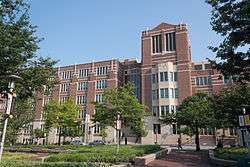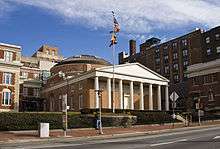University of Maryland School of Law
| University of Maryland Francis King Carey School of Law | |
|---|---|
 | |
| Parent school | University of Maryland, Baltimore |
| Established | 1816 |
| School type | Public |
| Dean | Donald B. Tobin[1] |
| Location |
Baltimore, Maryland, U.S. 39°17′21″N 76°37′21″W / 39.2893°N 76.6224°WCoordinates: 39°17′21″N 76°37′21″W / 39.2893°N 76.6224°W |
| Enrollment | 705 (JD, LLM & MSL) |
| Faculty | 49 full-time; 119 adjunct[2] |
| USNWR ranking | 48th (Tier 1)[3] |
| Bar pass rate | 73%[4] |
| Website |
www |
| ABA profile | LSAC Official Guide 2014 |
The University of Maryland Francis King Carey School of Law (formerly University of Maryland School of Law; sometimes shortened to Maryland Law or Maryland Carey Law) is the law school of the University of Maryland, Baltimore and is located in Baltimore City, Maryland, U.S. Founded in 1816 as the Maryland Law Institute with regular instruction beginning in 1824, it is the second-oldest law school in the United States, only behind William & Mary Law School and ahead of Harvard Law School. Because of its location, Maryland Law is part of the Baltimore-Washington legal and business community.[5]
In 2003, the law school moved into a new facility in downtown Baltimore near the Inner Harbor and Oriole Park at Camden Yards.[6] In 2011, the law school received a US$30 million donation from the W.P. Carey Foundation, which is the largest gift in the school's history. In response, the law school changed its name to the University of Maryland Francis King Carey School of Law.[7]
Maryland Law has been ranked consistently in the top tier of American law schools by U.S. News & World Report, maintaining its position in the rankings over the years. The law school was ranked 36th by the U.S. News & World Report in 2008,[8] and was ranked 48th as of the 2016 edition. The 2016 Rankings also gave Maryland Law top standing in health care law (#4), part-time program (#5), and clinical training (#7).[3]
Maryland Law is fully accredited by the American Bar Association (ABA). It is a member of the Association of American Law Schools and has a chapter of the Order of the Coif honor society.
Students and organizations

There are approximately 705 students enrolled at Maryland Law in the Juris Doctor (J.D.), Master of Laws (LL.M.), and Master of Science in Law (M.S.L.) programs combined.[2] The racial makeup of students in the J.D. program is approximately 60% white, with about 35% identifying as a minority race (and the remainder are unknown or did not specify). Around 72% of J.D. students are under 25 years old.[4]
There are more than 40 student organizations,[9] four specialized legal centers,[10] and five law journals.[11]
Academics and statistics
Employment outcomes
According to Maryland Law's official data reported to the American Bar Association, 91.1% of 2016 graduates were employed nine months after graduation.[12] For those who chose private practice, the median starting salary was $132,500.[13] According to Maryland Law's Law School Transparency (LST) report, nine months after graduation, 57.6% of 2015 graduates had obtained full-time, long-term legal jobs and 19.6% were under-employed, meaning they were unemployed, pursuing additional degrees, or working in a non-professional, short-term, or part-time jobs.[14]
Costs
The total cost of attendance (including tuition, fees, and living expenses) for the 2016–2017 academic year is $58,191 for Maryland residents and $73,944 for out-of-state students.[15]
Curriculum
The core curriculum at Maryland Law includes courses in civil procedure, constitutional law, Torts, property, contracts, and criminal law, as well as a two-semester course focusing on legal skills of analysis, research, writing, and oral argument.[16] These required courses form the basis for more specialized study through more than 150 elective courses, seminars, independent studies, simulations, clinics, and externships.
Specialty programs
Maryland Law is home to several specialty programs that enable students to explore areas of interest through experiential learning and a specialized curriculum.[10]
The main specialty areas include the following:[10]
- Advocacy
- Health Law
- Business Law
- Intellectual Property Law
- International and Comparative Law
- Legislation and Public Policy
- Women, Leadership & Equality
Students can focus in other areas as well, such as criminal law, dispute resolution, family law/child advocacy, general practice, jurisprudence/legal history, labor/employment/administrative law, property/real estate/decedent’s estates law, public interest law/community development, and tax law.
Dual-degree programs
The law school offers several dual-degree options:[17]
Business
Maryland Law has a combined J.D./M.B.A. through:[17]
- Robert H. Smith School of Business at the University of Maryland College Park
- Merrick School of Business at the University of Baltimore
- Carey Business School at The Johns Hopkins University
Public Policy
There are several dual-degree options in the field of public policy:[17]
- J.D./M.P.P. from the University of Maryland School of Public Policy[17]
- J.D./Ph.D through the University of Maryland Baltimore County School of Public Policy
- J.D./M.C.P. (Master of Community Planning) through the University of Maryland Urban Studies and Planning Program
Health
- J.D./Master of Public Health from the University of Maryland School of Medicine
- J.D./Master of Science in Toxicology Risk Assessment and Environmental Law from the University of Maryland School of Medicine
- J.D./Master of Science in Nursing from the University of Maryland School of Nursing (J.D./M.S.)
- JD/Doctor of Pharmacy from the University of Maryland School of Pharmacy
Law and Society
- J.D./Master of Arts in Criminal Justice through the University of Maryland College Park
- J.D./Master of Arts in Liberal Arts through St. John's College, Annapolis
- J.D./Master of Social Work through the University of Maryland School of Social Work (J.D./M.S.W.)
The Maryland LL.M.
The Maryland LL.M. Program provides legal education for lawyers and law students seeking to develop expertise in a specific area of study. It is a program designed for individuals from the U.S. and abroad.[18]
Clinical Law Program
Through the Cardin Requirement, named after Maryland Law alumnus U.S. Senator Benjamin Cardin, each full-time day student gains hands-on legal experience by representing actual clients who would otherwise lack access to justice. Most students fulfill the Cardin Requirement through the Clinical Law Program,[19] which provides free legal services to Maryland’s poorest citizens each year.
More than 25 clinics[20] focus on a broad range of practice areas, including civil and criminal litigation, advice and counseling, and transactional work. Civil practice areas include environmental law, health, housing and community development, juvenile law and children, AIDS, and immigration. Criminal student attorneys often represent defendants in misdemeanor cases in Maryland’s district courts, as well as work in the School of Law's community justice efforts. In addition to in-house clinical work, students may gain experience in public and private nonprofit externships in the Baltimore-Washington region.
Initiatives
In addition to formal Programs and Centers, the law school sponsors a variety of academic and public service initiatives. These initiatives enhance the educational and scholarly mission of the law school and also serve the community.[21]
Leadership, Ethics and Democracy (LEAD) Initiative
In spring 2008, the Fetzer Institute made a three-year $1.6 million funding commitment to the School of Law to help it respond to these challenges and create a Leadership, Ethics and Democracy program (LEAD).[22]
Legislation, politics, and public policy
The University of Maryland School of Law offers students an educational experience in the areas of legislation, public policy and public interest practice.[23]
Linking Law & the Arts
University of Maryland School of Law, in conjunction with local arts organizations and as part of the "Linking Law and Arts", series use theater and art to help address complex legal, social and public policy issues.[24]
As part of their commitment to blending law and the arts, students and professors at the University of Maryland School of Law produced a short film in 2010 about the handling of war tribunals at Guantanamo Bay entitled "The Response" starring Aasif Mandvi.[25]
UMD Carey Law is also one of less than ten law schools in the United States to offer a course in Visual Legal Advocacy, teaching students how to and encouraging them to incorporate cinema into their advocacy work.[26]
Law School complex and library
The School of Law and the Thurgood Marshall Law Library occupy a complex that supports the school’s programs integrating classroom and experiential learning. The facility opened in 2002 and contains three courtrooms, including the Ceremonial Moot Courtroom, where state and federal trial and appellate courts regularly sit in session to hear cases.[27]
The Thurgood Marshall Law Library houses a collection of more than 495,000 volumes and equivalents accessible through the online catalog.[28] A staff of 23, including 11 librarians, provides customized reference and consulting services to faculty and students. In addition to LexisNexis, Westlaw and Bloomberg Law, the library offers a legal and non-legal Web-based electronic databases.
Contrary to the commonly accepted history, Thurgood Marshall was not denied entry to the University of Maryland. In fact he never applied, as it was then common practice to deny all African Americans admission to the University of Maryland. Marshall went on to attend law school at Howard University.
Notable alumni
Publications
- Maryland Law Review
- Maryland Journal of International Law
- Journal of Business & Technology Law
- Journal of Health Care Law & Policy
- Journal of Race, Religion, Gender and Class
References
- ↑ "Faculty: Donald B. Tobin". UM Carey Law. Retrieved January 18, 2017.
- 1 2 "Prospective Students: Facts about UM Carey Law". UM Carey Law. August 22, 2016. Retrieved January 18, 2017.
- 1 2 "Best Law Schools: Ranked in 2016 – University of Maryland (Carey)". U.S. News & World Report. Retrieved January 18, 2017.
- 1 2 "Official Guide: 2014 ABA Data – University of Maryland Francis King Carey School of Law" (PDF). LSAC.org. Law School Admission Council, Inc. 2013. Retrieved January 18, 2017.
- ↑ "Law Schools: University of Maryland School of Law". Martindale.com Professional Resources. Archived from the original on November 14, 2004. Retrieved January 18, 2017.
- ↑ "Faculty: Karen Rothenberg". UM Carey Law. Retrieved January 18, 2017.
- ↑ "Carey Foundation Donates $30M to UMDLaw". UM Carey Law. Retrieved January 18, 2017.
- ↑ "New 2008 U.S. News & World Report Law School Rankings". Retrieved March 18, 2017.
- ↑ "Student Life: Student Organizations". UM Carey Law. Retrieved January 18, 2017.
- 1 2 3 "Programs & Centers". UM Carey Law. Retrieved January 18, 2017.
- ↑ "Academics: Journals". UM Carey Law. Retrieved January 18, 2017.
- ↑ http://www.law.umaryland.edu/prospective/documents/EmploymentSummary-2016.pdf
- ↑ http://www.law.umaryland.edu/prospective/documents/NALP_SUMMARY_CLASS2016.pdf
- ↑ "University of Maryland: Jobs – Latest Data". LST Reports. Law School Transparency. Retrieved January 18, 2017.
- ↑ "2016-2017 Estimated Cost of Attendance and Financial Aid: Carey School of Law" (PDF). University Student Financial Assistance and Enrollment Services. University of Maryland, Baltimore. Retrieved January 18, 2017.
- ↑ "Academics". UM Carey Law. Retrieved January 18, 2017.
- 1 2 3 4 "Academics: Dual Degree Programs". UM Carey Law. Retrieved January 18, 2017.
- ↑ "The Maryland LL.M". UM Carey Law. Retrieved January 18, 2017.
- ↑ "Maryland Law - Clinical Law". www.law.umaryland.edu. Retrieved April 12, 2018.
- ↑ "Maryland Carey Law - Course Catalog Search". www.law.umaryland.edu. Retrieved April 12, 2018.
- ↑ "Maryland Carey Law - Other Initiatives". www.law.umaryland.edu. Retrieved April 12, 2018.
- ↑ "Maryland Carey Law - About the Moser Initiative". www.law.umaryland.edu. Retrieved April 12, 2018.
- ↑ "Maryland Carey Law - Legislation, Politics, and Public Policy". www.law.umaryland.edu. Retrieved April 12, 2018.
- ↑ "Maryland Law - Linking Law & the Arts". www.law.umaryland.edu. Retrieved April 12, 2018.
- ↑ Administrator. "The Response - About the Movie". www.theresponsemovie.com. Retrieved April 12, 2018.
- ↑ "UM Carey Law | Abstracts & Professional Biographies". www.law.umaryland.edu. Retrieved 2015-06-09.
- ↑ http://www.law.umaryland.edu/dept/it/notebook_requirement.asp
- ↑ "Thurgood Marshall Law Library - University of Maryland Francis King Carey School of Law". www.law.umaryland.edu. Retrieved April 12, 2018.
